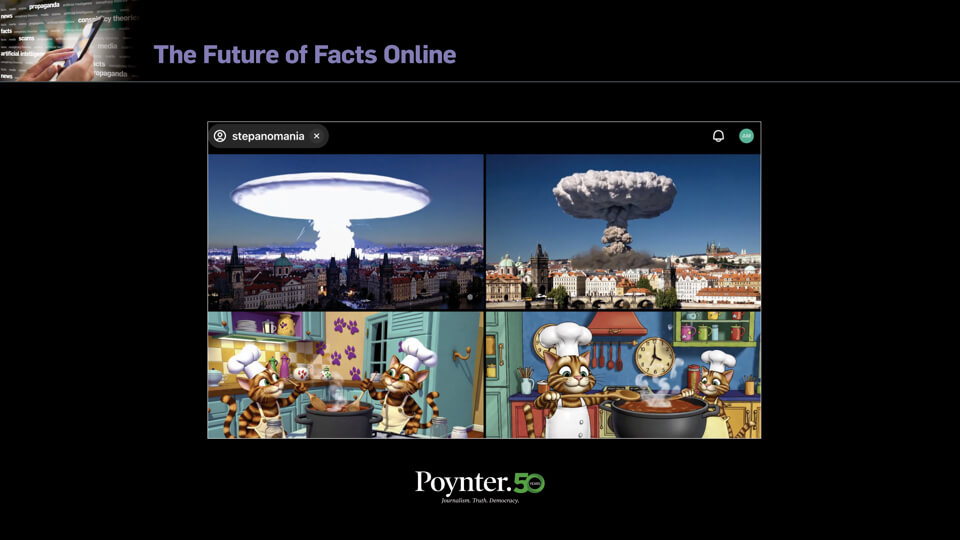As editors and reporters for many of the world’s leading news organizations sat in a room last week at Columbia University talking about the “Information Wars,” Yasmin Green, the director of research at Jigsaw, a Google subsidiary focused on digital threats, introduced the unsettling concept of the “Liar’s Dividend.”
You can hear Green’s entire explanation from the Craig Newmark Center for Journalism Ethics and Security Symposium in the video below. Here’s the concept in a nutshell: Debunking fake or manipulated material like videos, audios or documents, ultimately could stoke belief in the fakery. As a result, even after the fake is exposed, it will be harder for the public to trust any information on that particular topic.
This is a bigger problem than the Oxygen Theory, which argues that by debunking a falsehood, journalists give the claim a longer life. The Liar’s Dividend suggests that in addition to fueling the flames of falsehoods, the debunking efforts actually legitimize the debate over the veracity. This creates smoke and fans suspicions among at least some in the audience that there might well be something true about the claim. That’s the “dividend” paid to the perpetrator of the lie.
To dig back into ancient history for an example, in 2010 after robust reporting by almost every American news outlet that Barack Obama’s Hawaiian birth was certain, the intense debunking could not erase the doubt in the minds of a significant segment of the American public. At that point, 25% of Americans still thought it was likely or probable that Obama was born overseas. Well under half, only 42% of poll respondents, believed the facts as they had been conclusively demonstrated: that Obama was certainly born in the U.S. And 29% said they believed the president was probably born in the US. Certainly, political predisposition contributes to the existence of the Liar’s Dividend; in a polarized society, it can’t be minimized.
This is problematic for reporters and fact-checkers, and it buoys purveyors of misinformation. As NPR’s Media Correspondent David Folkenflik suggested at the symposium, “The idea is there’s just enough chum in water, it distracts people, nobody knows which to believe and they move on.”
Arguably, we can trace the concept of the Liar’s Dividend to a strategy employed by big tobacco in the 1980s. Faced with mounting research that cigarettes cause cancer, the Big Tobacco Playbook was employed to plant doubt in the public’s mind as a means to dispute the emerging science.
That strategy took advantage of a tendency within the press to look for opposing sides to duel in any story, a flawed reporting technique that eventually came to be known as false equivalency.
Just like the profession responded to the growing creep of false equivalency, journalists have options available to avoid contributing to a Liar’s Dividend. Here’s what they have to work with:
Competing news organizations should collaborate
When newsrooms take competition out of the equation, they give themselves time to identify deliberately false information and expose it for what it is. We’ve witnessed this as a successful strategy on big document dumps like the Chelsea Manning revelations in 2011, the Panama Papers in 2016 and the Paradise Papers in 2017.
“Maybe if you take the competition among the publications out of the equation, for some large news stories and there is collaboration, you have [more time]” said Victoria Baranetsky, general counsel for Reveal, at the symposium. She described how Reveal and the ICIJ worked on the Paradise Papers for nine months. “You went through, you had redactions, all the layers and all the steps that everyone in this room would want to say that they checked off all the boxes were done, and it was because the competitive streak was taken out.”
It’s harder to see how news organizations might collaborate on a juicy piece of audio or video during a chaotic political race. But not impossible.
Open up the reporting process to expose the fakery
Last month, when fabricated reports about Democratic presidential hopeful Pete Buttigieg emerged, several news organizations were quick to reveal the phony tips they’d been receiving. Among them was the Daily Beast, which pulled back the curtain for its audience to reveal a surreptitious recording made by one source and its interactions with a college student dragged into the plot as an alleged accuser.
It was slightly reminiscent of The Washington Post’s 2017 story on the attempt by Project Veritas to trick The Post into reporting fake allegations against Senate candidate Roy Moore.
By showing that good reporting starts with skepticism and isn’t predisposed to believe a tip until it can verify it, the news organizations diffused the fake news of both those stories, mitigating any Liar’s Dividend.
Recognize the flaws in the business model
Let’s not pretend the pressure to get traffic has no effect on decision-making. The first organization to publish a scoop gets 99% of the traffic. Yet clicks are only relevant to organizations dependent on advertising revenue. Sure, there’s ego and competition. But the real pressure comes from the financial payoff.
“That’s where the business model and particularly the ad-driven business model pushes people toward that kind of behavior,” said Mathew Ingram, writer for Columbia Journalism Review, at the symposium. “It does make you wonder if everything was subscription based, if everything was member-based, if everything was non-profit by choice instead of by accident, would that change the incentives? …If they thought more about ‘Is this in service of our members or our community?’ Instead of, ‘How many clicks can I get before someone yells at me for getting something wrong?’”
Resist using aggregation as ethical cover
When newsrooms aren’t on the front end of a juicy, sensational story, the next best option to capture traffic is to report on the reaction. Aggregate the tweets, write a few sentences of context, and hit publish.
Of course the only reason a newsroom would do that is if the business model rewarded such behavior. The antidote for that comes in your brand identity, said Michael Golden, retired vice chairman of The New York Times, at the symposium
“What is the brand that the news organization represents? That’s the first question. Is the business model in conflict with the brand?” Golden asked. “You can’t resolve ethical questions if the business model is in conflict with the brand…If the journalism businesses can’t resolve those questions, then their future is extremely fraught.”
The amount of deliberately falsified information is likely to increase, as will the sophistication of the fakes being pushed on reporters in a competitive news environment. Newsroom leaders who can discuss the dangers ahead of time and even prepare a protocol checklist or set of questions to ask will be more capable of making good publishing choices.
A good question to start with: What type of journalism have we promised our audience?
Correction: Due to a production error, this story previously had the wrong byline. It’s by Kelly McBride. We apologize for the error.








All good ideas. Certainly opening the newsroom’s decision-making process to the audience is perhaps the most important step journalists can take, and perhaps the hardest to do. Still, all of this my be a fool’s errand. There has been so much research done into this issue… neuroscience, psychology, sociology… and the fact remains, there is little we can do when people prefer to believe their values over facts. Great (and somewhat depressing) story from Neiman here — https://www.niemanlab.org/2019/05/fact-checking-cant-do-much-when-peoples-dueling-facts-are-driven-by-values-instead-of-knowledge/